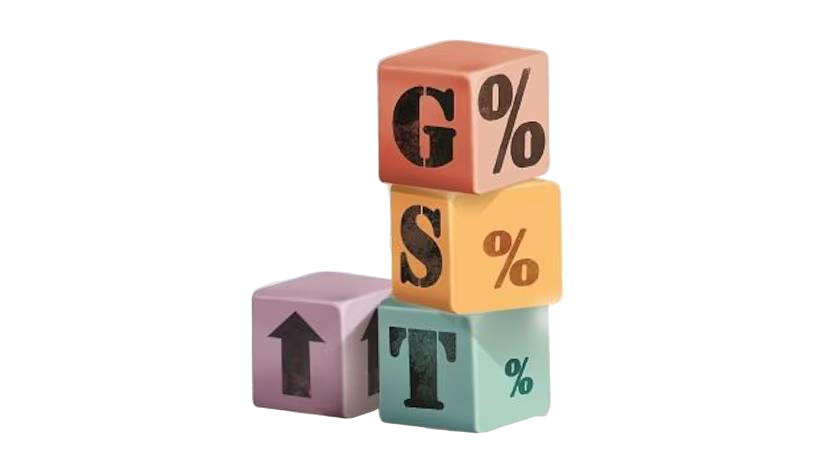What is a GST Rate?
A GST rate is the percentage of tax levied on goods and services supply under the Goods and Services Tax (GST) regime. GST, which came into being in India from July 2017, is a comprehensive indirect tax that has replaced various government and state taxes, such as VAT, service tax, excise duty, etc. GST rate is levied on the cost of goods or services, and both the Centre and States divide the revenue from taxation.
The GST rates aim to classify commodities and services on the basis of nature, use, and significance. Essential commodities and life-saving medicines either remain exempt or are charged lesser tax, while sin commodities and luxury items are taxed more. This assists in making the tax structure growth-oriented and progressive.
As per the 2025 amendments, India has proposed four major GST slabs: 0% (zero-rated), 5% (necessary/massy goods), 18% (normal goods and services), and 40% (luxury and sin goods). These rates are designed to ease the burden of the average consumer while allowing the government enough revenue from high-end consumption.
New GST Rates 2025
Here are India’s new GST rates as of September 2025 spelled out in detail: what’s changed, what’s cheaper, what’s still expensive, and how the architecture has been simplified.
What is GST 2.0? What is the reform?
- The Indian Government and GST Council have rolled out GST 2.0, a major revamp of the tax regime effective September 22, 2025.
- The aim is to simplify tax slabs, cut tax incidence on basic goods and services, and rationalise taxation so that “luxury” or “sin” goods are taxed at higher rates.
What has changed? Simplified GST rate slabs
Formerly (old structure): Multiple slabs: 0% (nil), 3%, 5%, 12%, 18%, and 28%, together with extra cesses on certain items.
The new pattern (from September 22, 2025) contains three principal slabs and a unique top slab.
- 0% (nil) for completely exempt items.
- 5% for “merit rate” items (essential/common use).
- 18% on normal goods and services. This is the new norm for most goods, which previously had 12% or 28%.
- A new “special rate” of 40% will be levied on hazardous, luxury, or status goods.
- The majority of goods will be shifted away from the 12% and 28% slabs to 5%, 18%, or 40%, as the case may be.
What are items now cheaper / shifted to lower slabs?
Most goods & services purchased by people will now draw less GST.
Previous GST system (prior to 22 September 2025)
- Nil (0%) slab – Levied on very few basic foodstuffs, some drugs, and basic products.
- 3% slab – Levied on gold, precious stones, and ornaments.
- 5% slab – Covered some basic products like basic foodstuffs, economy class airfare, and some household products.
- 12% slab – Used on most processed foods, domestic goods, and certain industrial inputs.
- 18% slab – Most commonly used slab, used on most services and goods like electronics, telecom, financial services, and routine consumer products like shampoo, toothpaste, etc.
- 28% slab – The most prevalent common slab, charged on sin and luxury commodities like cars, ACs, refrigerators, high-end electronics, and some tobacco products. Besides, compensation cess was charged on goods like luxury cars, tobacco, and aerated beverages.
The new structure of GST, effective 22 September 2025, brings various changes.
- The Nil (0%) slab includes more day-to-day essentials now. Exemptions include staples like chapati, khakhra, pizza bread, UHT milk, and stationery articles (pencils, erasers, crayons, geometry boxes), as well as life-saving drugs.
- The 5% slab has been termed the “merit rate.” This segment now includes basic and essential items like hair oil, soaps, toothpaste, shampoos, toys, handicrafts, diagnostic kits, thermometers, irrigation equipment, and fitness services like gyms and salons.
- The 18% slab is the new “standard rate.” All the items that were taxed at 12% or 28% GST have been brought under this one slab. For example, many cars, electronics, and consumer goods earlier taxed at 28% are now taxed at 18%.
- The 40% slab is introducing a new high rate of taxation for “luxury and sin goods.” These are high-speed vehicles, luxury imports, tobacco, cigarettes, aerated drinks, and other goods identified as harmful or status goods.
In simple words:
- Earlier, there were six slabs (0, 3, 5, 12, 18, 28 + cess).
- Now there are four slabs (0, 5, 18, and 40).
- The middle slabs (12% and 28%) have been done away with. Their items have been classified as either 5% (vital/common) or 18% (normal/luxury but not harmful).
- A new 40% rate of tax levies a heavy tax on luxury and sin items.
Goods that are still taxed at a high level (or have been shifted upward)
While tax relief has been granted to most items, some still are or are now taxed at a higher rate, especially those that fall under the “luxury,” “sin,” or harmful product category:
- A new 40% slab for luxury/sin items has been introduced. These include items like premium cars, tobacco/cigarettes, and aerated drinks.
- Certain goods that used to be taxed at moderate levels are now more costly or in a higher tax category if they are categorized as “luxury/harmful.” Large or high-end vehicles and possibly imported high-end products are some of the examples.
Effective date, implementation and impact
- The new GST rates take effect from 22 September 2025.
- They were ratified unanimously in the GST Council (i.e. states & Centre agreed) during their 56th meeting.
- Government/states’ revenue loss estimated due to these rate reductions is substantial, but it’s hoped that enhanced consumption, easier administration, and wider compliance will offset it partially.
Changes in GST Registration and Return Filing
GST Registration changes
- The threshold limit provided in the CGST Act will not change, even after the recent rate changes.
- Data from UPI transactions is being used to identify dealers who are not registered.
- Some of the businesses classified as “non-risky” would get faster registration (more information in the coming days).
Key Changes: GST Return Filing
- With effect from July 2025, the figures in GSTR-3B will be non-editable and auto-populated. With effect from the tax period of July 2025 (return due on August 2025), Table-3 of GSTR-3B (which captures outward supplies and tax payable) will be auto-populated on the basis of details filed in GSTR-1, GSTR-1A, or the Invoice Furnishing Facility (IFF). These auto-populated values will not be made manually editable. The corrections pertaining to outflows or taxes should be carried out through GSTR-1, GSTR-1A, or IFF before filing GSTR-3B.
- The time-bar rule allows the filing of old returns within three years. Returns filed later than three years from the initial deadline will be rejected. The enforcement of the “barred” period will start from July 2025.
- New forms for GSTR-7 and GSTR-8 (TDS/TCS returns). From February 11, 2025, the forms of GSTR-7 (tax deducted at source) and GSTR-8 (tax collected at source for e-commerce) will need more invoice-level information.
- Greater simplicity, faster reimbursements, and fewer compliance burdens. “GST Reforms 2025” is an initiative by the government aimed at simplifying registration, return filing, and refund of MSMEs and start-ups. Firms need to adapt their invoicing and systems to guarantee the use of the right GST rates from September 22, 2025.
Conclusion
The projected Goods and Services Tax rates for 2025 are a revolutionary shift in India’s tax structure, towards increased simplicity, clarity, and justice. The government has halted this by lowering the tax rates to just four slabs: 0%, 5%, 18%, and 40%. uncertainty and clashes about too many prices.
Making essential supplies—including basics, personal care goods, medications, and study materials—more accessible provides quick relief to families while also helping the general population. The lower tax rates are also anticipated to spur demand in industries including consumer durables, pharmacy, food, and FMCG.
Conversely, under the new 40% slab luxury and discretionary goods will be taxed at a higher rate to guarantee revenue neutrality and deter superfluous consumption. By simplifying corporate compliance and enabling a more citizen-centered, growth-oriented approach, the revised GST structure generally strikes a balance between social responsibility and economic growth. and eventually a progressive tax system.










Leave a comment